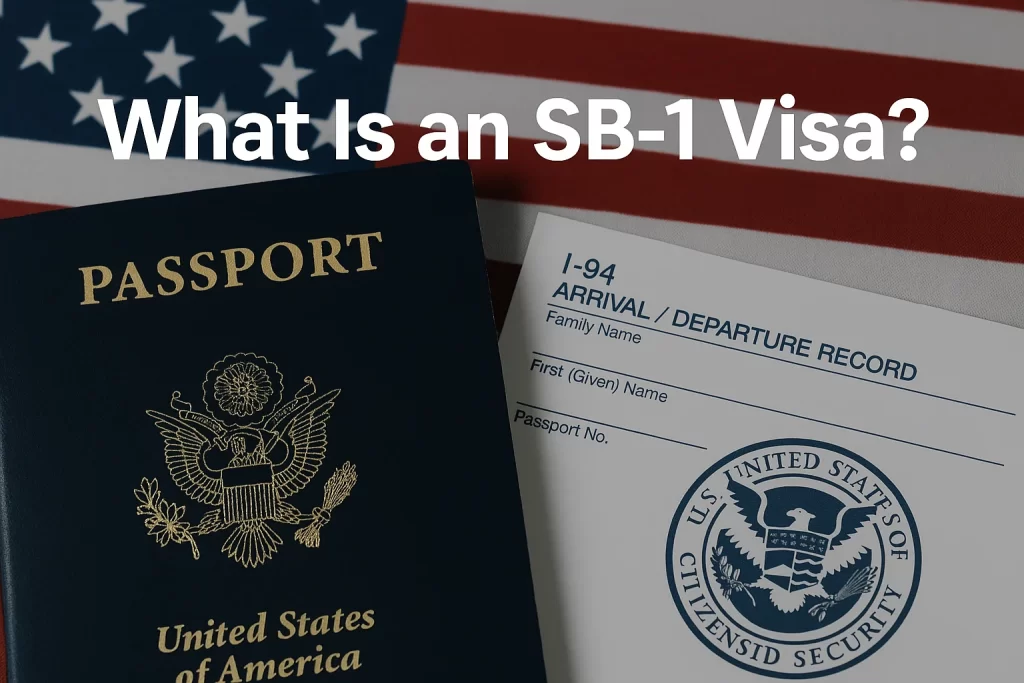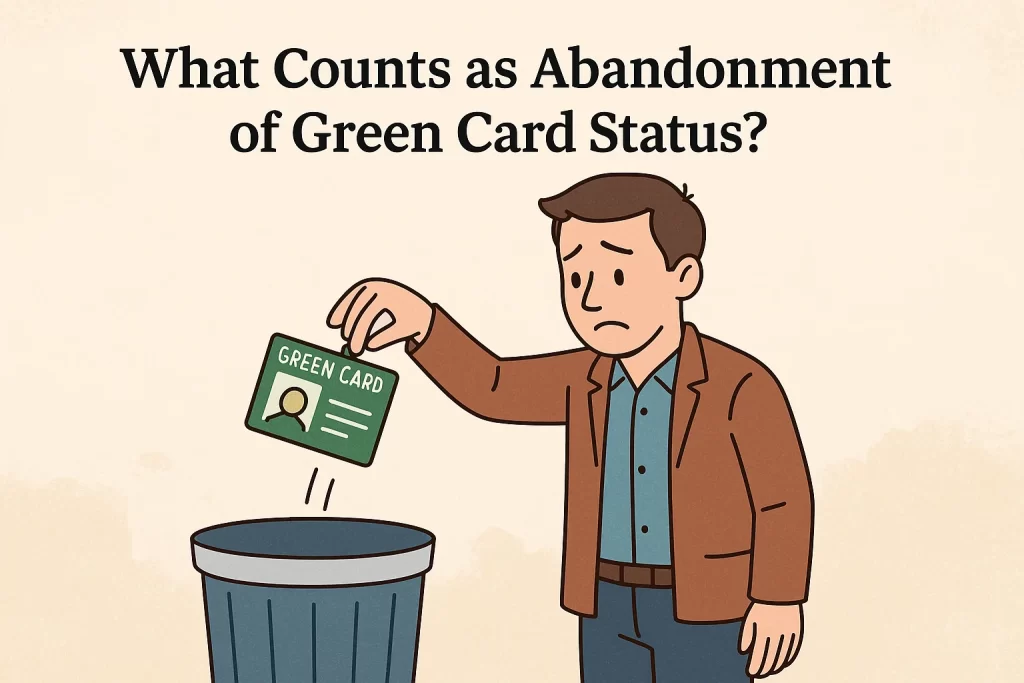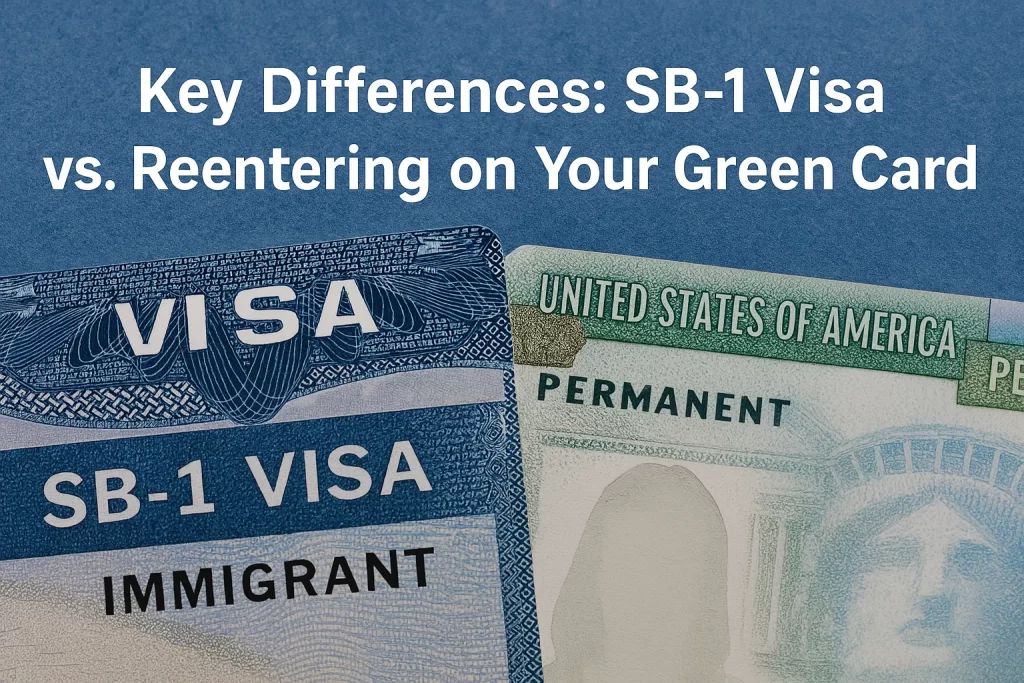So you’ve been out of the U.S. for a while—maybe longer than expected. Life happens, right? A family emergency, job commitments, a pandemic, or just bad timing. Now you’re staring at your green card and wondering: Can I just walk back in? Or do I need a visa? What is the success rate for this elusive visa?
This is where things get real tricky. There are two paths: try to reenter on your green card or apply for an SB-1 Returning Resident Visa. But here’s the kicker—one of those options could slam the door shut on your immigration status for good.
Many people think applying for an SB-1 is the “official” route if you’ve been gone too long. But immigration attorneys will tell you: that’s often a trap. Unless you can prove it was literally impossible to return within a year, like you were in a coma or stranded by war, chances are high that your SB-1 will get denied. And if that happens, you’re done. No green card. No chance to fight.
Meanwhile, just flying in with your green card—even if you’ve been out longer than a year—might still work. Worst case? CBP thinks you’ve abandoned your green card, but guess what? You can fight that in court, where your odds are usually way better than at a U.S. consulate.
In this guide, we’ll break it all down—no fluff, no scare tactics, just the truth. You’ll learn the real differences between the SB-1 visa and reentering with your green card, when each applies, and what’s really at stake.
🧱 What Is an SB-1 Visa?

Let me tell you about a friend of mine—let’s call him “Sami.” He stayed abroad taking care of his dad who was dying. It went a little over a year. He applied for SB-1 thinking the consulate would understand. But no. They said, “You could’ve returned and then flown back out.” Denied. No more green card. Just like that. And the worst part? There was no appeal. No judge. No second chance.
Once your SB-1 is denied, you’ve lost the green card and your ability to fight for it. It’s a done deal.
Now compare that to just flying back in with your green card. Even if you’ve been away more than a year, CBP might let you in. Or maybe they’ll flag you and say you abandoned your residency. But here’s the silver lining—you still get to make your case in immigration court. You get a lawyer. Evidence. A fighting chance. With SB-1? Not so much.
To apply for SB-1, you need to file Form DS-117, pay fees, prove compelling reasons for the delay, attend a consular interview, and still pray the officer sees it your way. It’s a lot of time, money, and stress for something that often ends in rejection.
So yeah, the SB-1 might sound like the “proper” option, but for most people, it’s not the smartest one. Think long and hard before you apply.
🧾 What Counts as Abandonment of Green Card Status?

Okay, let’s clear this up because abandonment is one of those scary words that gets thrown around a lot when you’ve been away too long. And if you’re like me, you’ve probably Googled it late at night thinking, “Wait… did I just lose my green card??”
Here’s what’s real: just staying outside the U.S. for more than 6 months—or especially more than 1 year—raises red flags. It doesn’t automatically mean you abandoned your residency, but it puts you in the danger zone.
The government looks at more than just the calendar. What they really want to know is whether you intended to give up your U.S. residence. And that’s where things get messy.
Let’s say you left for a 3-month vacation that turned into 13 months because your mom got sick, your flight got canceled, or life just fell apart. If you can show that your intention was always to return, and you’ve got proof—like keeping a U.S. address, paying taxes, having family here—you might still be okay.
But if you sold your house, canceled your job, and enrolled your kids in school abroad? Yeah, that looks bad.
The Customs and Border Protection (CBP) officer at the airport decides in the moment whether to let you in or send you to immigration court. And they’ll ask stuff like:
-
How long have you been gone?
-
Why did you stay so long?
-
Do you still have ties to the U.S.?
And get this: even if you’ve only been gone 8 or 9 months, they can still accuse you of abandonment if it looks like you were setting up a new life elsewhere. I’ve heard of people who got grilled just for traveling back and forth too often.
But here’s a key point—CBP isn’t the final say. If they think you abandoned your green card, you still have the right to go before an immigration judge. You get to argue your case, present documents, and explain your situation. That’s a huge advantage over the SB-1 process.
So yeah, the 1-year rule is important, but it’s not the end-all. What really matters is intent, evidence, and what you do next. Be prepared, stay calm, and don’t let fear make you give up your rights.
🛬 When Can You Reenter the U.S. on a Green Card Without a Visa?

Let’s be real—this is the section most people are hunting for when they land on this topic. You’re sitting abroad, staring at your green card, thinking: “Can I just get on a plane and come back?” The answer? Sometimes yes, sometimes no—but there’s a lot more wiggle room than people think.
If you’ve been outside the U.S. for less than 6 months, you’re golden. CBP might ask you some questions, but generally, you’ll be let back in like any other returning resident. This is the sweet spot.
Now, 6 to 12 months? That’s a gray area. You can still come in using your green card, but you may get pulled aside for secondary inspection. CBP may ask about your ties to the U.S., where you’ve been staying, and why you were gone so long. It’s uncomfortable, sure, but you’re still in the game.
Here’s where it gets intense: if you’ve been gone for over 1 year, the U.S. government technically considers your green card expired for travel purposes. But here’s the thing—your green card doesn’t magically disappear. It’s not like your status just vanishes. And many people have walked right back into the U.S. after 13, 14, even 18 months out.
How? They had strong proof they never meant to abandon their residency. Stuff like:
-
U.S. tax returns filed during their time away
-
A home or lease still in their name
-
Utility bills, bank accounts, or driver’s license
-
Medical records or family emergencies explaining the long stay
Some even bring letters from U.S. employers or schools showing their intention to return. I had a colleague who returned after 15 months with hospital discharge papers and a letter from their U.S. employer confirming she was still on payroll. CBP gave her a warning, but let her in.
Now, reentry permits are the best insurance policy if you know you’ll be gone for a while. Apply before leaving the U.S., and it lets you stay outside for up to 2 years without triggering abandonment issues. But if you didn’t get one—don’t panic yet.
Bottom line? You can reenter without a visa in many cases, especially if you’re prepared and can show your trip wasn’t a permanent move. And even if CBP challenges you, you’ve got way more options to defend your status than if you’d gone the SB-1 route and got denied at a consulate.
📑 Key Differences: SB-1 Visa vs. Reentering on Your Green Card

Alright, now let’s lay it all out. You’ve probably already guessed that reentering with your green card is usually a better move than applying for an SB-1 visa. But let’s break it down so you can see exactly why.
🔄 Application Process
First off, SB-1 requires you to go through a full consular process. That means:
-
Filling out Form DS-117
-
Gathering a pile of documents to prove your trip was “beyond your control”
-
Paying hefty fees
-
Booking a medical exam
-
Attending an in-person interview at a U.S. embassy or consulate
Compare that to reentering with your green card: you book a flight, show up at the airport, and present your green card. That’s it. Even if you’re pulled into secondary inspection, it’s still way less of a bureaucratic nightmare than an SB-1 application.
⚖️ Burden of Proof
This one’s huge. With SB-1, you have to prove that it was literally impossible to return within a year. Not inconvenient. Not difficult. Impossible. We’re talking war, natural disasters, medical comas. If the consular officer thinks you could’ve come back sooner but didn’t, you’re done.
On the flip side, if you reenter with your green card—even after 12+ months—the burden is different. CBP might challenge you, but you still have the chance to make your case in immigration court, where real evidence matters and you’re not at the mercy of one officer’s opinion.
❌ Denial Consequences
Here’s the real scare factor: if your SB-1 visa is denied, you’re out of luck. You lose your green card and your chance to argue for it. There’s no appeal. No hearing. Just… game over.
But if CBP accuses you of abandonment at the airport, you still have a shot. They can issue a Notice to Appear (NTA), and you go before an immigration judge to argue your case. You get a lawyer, evidence, due process—the whole nine yards.
💸 Cost and Hassle
SB-1 isn’t just risky—it’s expensive and slow. Between the visa fees, medical exam, documentation prep, and time off work, it adds up. And even then, the approval rate is extremely low.
Green card reentry? Maybe a tough conversation at the airport. Maybe even a referral to immigration court. But you’ve still got skin in the game.
Comparison of the Options
| Feature | SB-1 Visa | Green Card Reentry |
|---|---|---|
| Requires Visa Application | ✅ Yes | ❌ No |
| Prove Intent to Return | ✅ Yes (very high bar) | ✅ Yes (but in court, not consulate) |
| Denial = Lose Green Card | ✅ Often permanent | ❌ You can fight it in court |
| Approval Rate | ❌ Very low | ✅ Usually better chance |
| Cost and Hassle | ❌ High (fees, interview, medical) | ✅ Minimal |
| Ability to Appeal | ❌ No appeal | ✅ Yes—immigration court |
📍 How to Decide Which Path Is Right for You

Alright, so you’ve been out of the country longer than planned. Maybe just over a year, maybe a lot longer. Now you’re stuck at the crossroads: SB-1 visa or just show up with your green card and see what happens?
Let me be totally honest—most immigration lawyers will tell you to avoid the SB-1 unless you truly have no choice.
🧠 Ask Yourself These Questions:
-
How long have you been outside the U.S.?
-
Did you have a valid reentry permit?
-
Why couldn’t you return sooner?
-
Do you have proof that it was impossible to return within 12 months?
-
Can you show strong ties to the U.S.—like a job, home, taxes, or family?
-
Are you willing to take the risk of being turned away at the consulate?
If your answers are shaky, you may not have a solid SB-1 case. Consular officers are trained to sniff out weak excuses, and if they believe you could have returned earlier—even if it would’ve been hard—they’ll deny your SB-1 visa. No hearing. No appeal. Just a goodbye wave to your green card.
And here’s the scary part: once that SB-1 is denied, it’s game over. Your green card’s gone, and you probably won’t get a chance to fight it. You’ve basically admitted to abandonment by asking for the visa in the first place.
💡 Why Reentering on Your Green Card Might Be Better
Now, let’s say you just show up with your green card—even if it’s been over a year. CBP might let you through with a warning. Or, they might challenge you and send you to immigration court. Scary? Yeah. But here’s the thing:
-
You get a lawyer.
-
You can bring evidence.
-
You have time to build your case.
-
You’re not at the mercy of a single consulate officer.
Even if you lose in court, at least you got to fight. With SB-1? You don’t even get to throw the first punch.
✅ When SB-1 Might Make Sense
Look, there are exceptions. If you were genuinely stranded—like hospitalized, war zone, pandemic lockdown—and you have documents to back that up? Then SB-1 could work. But that’s rare.
Checklist Recap:
-
❌ Avoid SB-1 if your delay was due to caregiving, finances, work, or travel delays
-
✅ Reenter with your green card and be ready to explain and prove intent
-
✅ Bring evidence: tax returns, utility bills, pay stubs, property documents, etc.
-
✅ Be calm and cooperative at the border—don’t argue
-
✅ If they say you abandoned your residency, ask for a Notice to Appear so you can fight in court
💡 Conclusion: Don’t Let Time Abroad Derail Your Status
So here we are. If you’ve made it this far, you already know—being out of the U.S. for too long as a green card holder is a big deal. But the way you handle your return makes all the difference.
Sure, the SB-1 visa sounds official. It’s got a form, a process, an interview—feels like the “right” way. But it’s also a trap for a lot of people. The burden of proof is sky-high, the approval rate is depressingly low, and worst of all? If they deny it, you lose your green card and your chance to fight.
On the flip side, showing up with your green card—even after a year away—may sound risky, but it often gives you a better shot. Why? Because if CBP flags you for abandonment, you still have due process. You get a chance to explain your situation in court, with a lawyer, evidence, and a judge—not just a single consular officer making a snap decision.
So here’s the bottom line:
-
If you’ve been out of the U.S. for a while, don’t assume the SB-1 is your only path back.
-
Don’t panic. Don’t give up. And definitely don’t apply for SB-1 without talking to an immigration lawyer first.
-
If you can, just try to reenter with your green card—prepared, calm, and ready to defend your intent.
Everyone’s situation is different. But the more you understand the system, the more power you have to make smart choices and protect your residency.
If you’ve been through this—or are going through it now—drop your experience or questions in the comments. You might help someone else who’s freaking out about the same thing.
If you still need more advice, contact us to discuss your case further.
📚 Further Reading
Want to dig deeper into the SB-1 visa, green card abandonment, or reentry procedures? Check out these official and trusted resources:
-
U.S. Department of State – SB-1 Returning Resident Visa Overview
https://travel.state.gov/content/travel/en/us-visas/immigrate/returning-resident.html -
U.S. Citizenship and Immigration Services (USCIS) – Maintaining Permanent Residence
https://www.uscis.gov/green-card/after-we-grant-your-green-card/maintaining-permanent-residence -
CBP – Bringing Permanent Residents Back to the U.S.
https://help.cbp.gov/s/article/Article-752?language=en_US -
AILA (American Immigration Lawyers Association) – Why SB-1 Visas Are So Difficult to Get
https://www.aila.org/advo-media/aila-practice-pointers/sb-1-visas-challenges -
ImmiHelp – SB-1 Visa Application Tips and Requirements
https://www.immihelp.com/sb1-returning-resident-visa/
